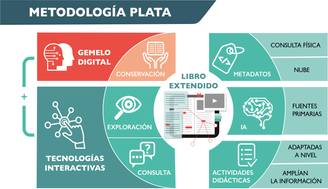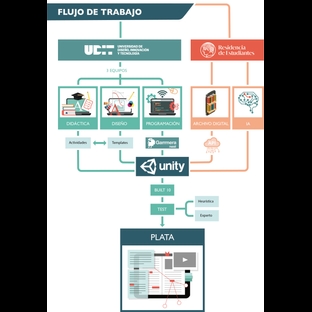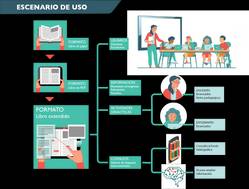Archive Digitisation Project with Interactive Technology (SILVER)
Project title: Proyecto de digitalización de Archivos con Tecnología interactiva (PLATA) / Archive Digitization Project with Interactive Technology.
IP Project:Phd. Rafael Conde Melguizo (rafael.conde@udit.es)
objectives
The objective of the PLATA project is the development of educational prototypes to digitise the editorial collection of the UDIT Student Residence in order to be used as teaching material in Secondary, Baccalaureate and University, both for use in the classroom and for independent research work at all levels, including dissertations and doctoral theses. The project offers the opportunity to digitise the editorial collection in a modern and enduring interactive format in accordance with the current uses of the new generations and facilitating the work of consultation and reading through interactive technologies, consultation of files in the cloud and artificial intelligence.

Methodology
PLATA provides a novel methodology to extend the functions of the digital twin. The main function of a digital twin is preservation.
This focuses on preserving heritage in a durable digital format that is true to the original. Through digitisation and advanced prototyping, the physical object is replicated in a digital twin that contains all the details and characteristics of the original object at the highest possible level of accuracy. This replica not only serves as a backup copy of the physical object, but also meets digital preservation standards, ensuring that the relevant information endures and is available for future generations.
In the case of the SILVER methodology, the digital twin also fulfils other functions. For example, in the consultation function, the possibilities of use of the digitised objects are expanded by integrating them into interactive experiences. Unlike a simple scanning or modelling of a physical object - such as a book, a building or a recording - the standard proposed in PLATA turns these objects into interactive digital environments that allow the exploration of the object, but also of the archives related to the content. Thus, from a book containing a chapter dedicated to Einstein, it is possible to consult photographic, video or other archives about this scientist and his work.

From the digitised book, the user can ask questions to an AI that has been trained only with the primary sources of the archives, which allows a didactic use of the AI free of disinformation or bias, including the possibility of going to the primary source consulted by the AI to contrast the information.
PLATA has also developed a work methodology or workflow that will allow future projects to tackle digitisations of scientific and cultural heritage with the same interactive functionalities, archive consultation and use of AI.

Practical applications
One of the main strengths of the PLATA project is its applicability in the classroom.
We work with digital tools and active methodologies that encourage student motivation, use cross-information searches and encourage the appropriate use of AI in the classroom. All with the aim of recovering heritage and helping students to have a more complete, more transversal and inclusive education.
